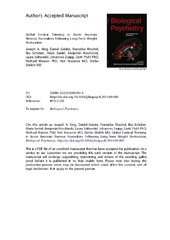| dc.contributor.author | King, Joseph A | |
| dc.contributor.author | Geisler, Daniel | |
| dc.contributor.author | Rischel, Franziska | |
| dc.contributor.author | Schober, Ilka | |
| dc.contributor.author | Seidel, Maria | |
| dc.contributor.author | Roschinski, Benjamin | |
| dc.contributor.author | Soltwedel, Laura | |
| dc.contributor.author | Zwipp, Johannes | |
| dc.contributor.author | Pfuhl, Gerit | |
| dc.contributor.author | Marxen, Michael | |
| dc.contributor.author | Roessner, Veit | |
| dc.contributor.author | Ehrlich, Stefan | |
| dc.date.accessioned | 2017-01-24T08:18:38Z | |
| dc.date.available | 2017-01-24T08:18:38Z | |
| dc.date.issued | 2014-09-22 | |
| dc.description.abstract | <b>Background:</b> Anorexia nervosa (AN) is a serious eating disorder characterized by selfstarvation,
extreme weight loss and alterations in brain structure. Structural magnetic
resonance imaging (sMRI) studies have documented brain volume reductions in acute AN,
but it is unclear whether they are 1) regionally-specific or 2) reversible following weight
restoration. Here, we measured cortical thickness (CT) for the first time in AN.<br>
<b>Methods:</b> sMRI data was acquired from adolescent and young adult female patients with
acute AN (acAN; n = 40), recovered patients following long-term weight restoration (recAN;
n = 34) and an equal number of age-matched healthy controls. Group differences in CT
were tested with well-validated procedures implemented in FreeSurfer. The mediating role
of clinical variables including body-mass-index and “drive for thinness” were explored. For
completeness, we also used FreeSurfer’s subcortical segmentation stream to test group
differences in volumes of select gray matter regions of interest (ROIs).<br>
<b>Results:</b> Vertex-wise analyses revealed significant thinning of over 85% of the cortical
surface in acAN and normalization in recAN, although normal age-related trajectories were
absent in the disorder. This pattern of results was largely mirrored in subcortical volumes.
We also observed a strong negative correlation between CT and “drive for thinness” in
extrastriate regions involved in body perception.<br>
<b>Conclusions:</b> Structural brain anomalies in AN as expressed in CT and subcortical volume
are primarily the consequence of malnutrition and unlikely to reflect premorbid trait markers
or permanent “scars”, but longitudinal data are needed. | en_US |
| dc.description | This is the accepted manuscript version. Published version can be found at <a href=" http://dx.doi.org/10.1016/j.biopsych.2014.09.005">http://dx.doi.org/10.1016/j.biopsych.2014.09.005</a> | en_US |
| dc.identifier.citation | Biological Psychiatry 2015, 77(7):624-632 | en_US |
| dc.identifier.cristinID | FRIDAID 1179665 | |
| dc.identifier.doi | 10.1016/j.biopsych.2014.09.005 | |
| dc.identifier.issn | 1873-2402 | |
| dc.identifier.issn | 0006-3223 | |
| dc.identifier.uri | https://hdl.handle.net/10037/10188 | |
| dc.language.iso | eng | en_US |
| dc.publisher | Elsevier | en_US |
| dc.rights.accessRights | openAccess | en_US |
| dc.subject | anorexia nervosa | en_US |
| dc.subject | cerebral cortex | en_US |
| dc.subject | cortical thickness | en_US |
| dc.subject | FreeSurfer | en_US |
| dc.subject | MRI | en_US |
| dc.subject | subcortical structures | en_US |
| dc.subject | VDP::Samfunnsvitenskap: 200::Psykologi: 260::Biologisk psykologi: 261 | en_US |
| dc.subject | VDP::Social science: 200::Psychology: 260::Biological psychology: 261 | en_US |
| dc.title | Global cortical thinning in acute anorexia nervosa normalizes following long-term weight restoration | en_US |
| dc.type | Journal article | en_US |
| dc.type | Tidsskriftartikkel | en_US |
| dc.type | Peer reviewed | en_US |


 English
English norsk
norsk